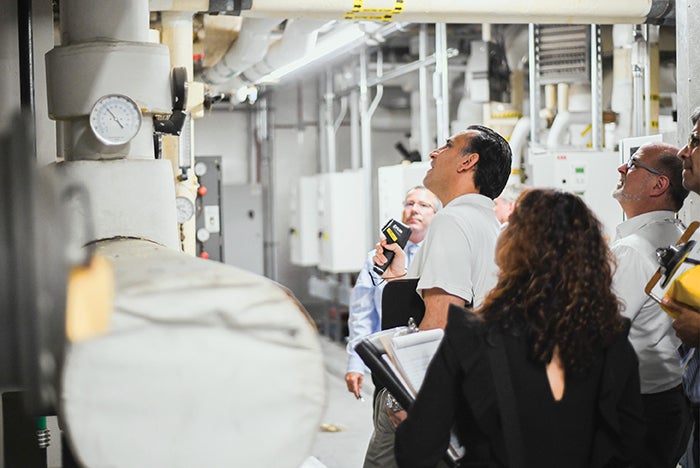ASHE launches decarbonization initiatives

Image by Getty Images
While sustainability has become the focus of increased attention in recent years, energy and resource management practices are not new. Since the first health care facilities manager was handed an electric bill, health care organizations have been looking for ways to conserve energy use and manage costs.
What’s different in today’s world is the ever-growing urgency to reduce the use of utilities and other resources, not just as a matter of frugality but also responsibility. Driven by factors like skyrocketing inflation, climate change, social pressure and new government regulations, health care facilities managers must do more with fewer resources as sustainability initiatives have shifted into a top priority.
Key initiatives
Recognizing this growing urgency, the American Society for Health Care Engineering (ASHE) has developed several tools and programs to help facilities managers with their sustainability efforts. The following reviews the top three key sustainability initiatives driven by ASHE that aim to reduce the environmental impact of health care while also saving another of the field’s precious resources — money.
1. Executive Toolkit for Sustainability. One of the most difficult parts of launching a sustainability program at a health care facility is justifying the need and benefits with upper management. Health care is a major generator of carbon emissions — making up a staggering 8.5% of all U.S. emissions. This fact and other concerns have caused many in the field to recognize the need to formalize sustainability and decarbonization programs in their operations.
The American Hospital Association (AHA) and ASHE "Health Care Leader’s Guide to Sustainability and Environmental Stewardship" offers facilities managers and sustainability team members the value proposition for sustainability programs, customized to each area of health care executive leadership — CEOs, COOs, CFOs and boards of directors.
“Executive leadership wants to advance sustainability, but they may not know how or where to start,” says Peter Dahl, Ph.D., CEM, LEED AP, consultant with Define Sustainability and author of the guide. “This guide provides the resources to get everybody moving in the same direction.”
Written with the health care leadership audience in mind, the guide concisely summarizes the fundamentals of sustainability and decarbonization and discusses why sustainability efforts are needed, how formal sustainability programs can create value for organizations, ways to track carbon usage and communicate reduction goals, and specific actions each executive role can take to make sustainability a transformational program for organizations. The guide also offers the business case for each executive and how sustainability efforts can reinforce the mission of health care and reduce risk. For example, CFOs are in a great position to use their existing financial accounting tools to track sustainability efforts in a facility, Dahl says. The guide offers CFOs areas to track sustainability, from energy use and utility cost reduction to procurement of supplies and other resources — things like office paper all the way up to medical equipment.
“Sustainability and decarbonization improve organizational resilience and community health outcomes, which is really what our health care organizations are all about at the strategic level,” Dahl says. “It’s in their mission.”
The guide offers direction for each area of executive management because universal buy-in and support are needed if a health care organization wants to advance sustainability and decarbonization, Dahl says.
“This can’t be delegated to one person. Sustainability requires a transformational approach to affect real change,” Dahl says. “Every employee in the organization must be empowered to seek sustainability practices, learn about how they can advance sustainability and decrease emissions. With this guide, we hope to grow leaders in our health care organizations who will take action.”
2. Energy to Care® Dashboard. Health care sustainability efforts are often compared to a journey, and any well-planned trip typically starts by creating a roadmap. The AHA’s Sustainability Roadmap for Health Care™ charts out this journey for health care organizations, setting a course for changes in operations, procurement, purchasing, maintenance and even new models of care that conserve resources while improving health.
Tracking milestones helps the traveler monitor their progress, which is also the concept behind the Energy to Care Dashboard®. A core piece of the Sustainability Roadmap for Health Care, the free dashboard tracks a facility’s use of electricity, steam, water, natural gas and Scope 1 and 2 emissions as they implement strategies.
As more local and state authorities having jurisdiction implement sustainability requirements across the country — and The Joint Commission launches a national voluntary sustainability certification — having the ability to track and benchmark progress on energy and resource reduction has become increasingly important.
The Energy to Care Dashboard allows facilities to establish a baseline on their energy consumption by inputting their utility use and other information, and then track their sustainability progress while participating in program-guided energy saving and resource reduction exercises. Participants who hit high sustainability benchmarks on the dashboard are issued Energy to Care Awards each year by ASHE.
Atrium Health, a large health care system in the southeast U.S. that includes 22 acute care facilities, has used the Energy to Care Dashboard for over 10 years to track energy, water and greenhouse gas (GHG) emissions. Its reduction efforts using the dashboard won it several 2023 Energy to Care Sustainability Champion Awards and helped it hit numerous impressive sustainability goals.
“The dashboard is a very nice, graphical representation of energy consumption at our hospitals that allows us to benchmark,” says Michael Roberts, PE, CHFM, SrHE, SASHE, director of enterprise energy services at Atrium Health. “It helps us identify where the hospital is versus where it could be compared to the national average, and which hospitals have the best opportunities for improvement. That data helps build the business case for making improvements.”
For example, Atrium Health, part of Advocate Health, reduced energy usage by 35% across its entire acute care portfolio, which has translated into millions of dollars in savings.
At Atrium Health Lincoln, a 101-bed hospital in Lincoln, N.C., this drop in energy consumption adds up to $103,000 in annual energy savings. The reduction was done by retrocommissioning building automation systems, implementing operating room airflow setbacks and energy-efficient control sequences, and optimizing chilled water systems. At Atrium Health Mercy, a 185-bed hospital in Charlotte, N.C., green systems and practices (e.g., airflow setbacks in operating rooms, upgrading outmoded pneumatic HVAC controls with energy-efficient direct digital controls and retrocommissioning different building automation systems) have reduced annual energy consumption by over a third and saved $530,000 annually.
For those beginning their sustainability journeys, Roberts recommends starting with three things: networking through ASHE with others on the sustainability journey to gain tips, celebrating sustainability wins with engaged team members and developing concise benchmarks using Energy to Care.
In fact, thanks to a new report from ASHE, sustainability benchmarks have become even more clear. Data from nearly 1,000 Energy to Care participant health care organizations was recently analyzed in the “Energy Benchmarking for US Hospitals” report, which shares specific benchmarks set by U.S. region and even hospital size.
“If you are not benchmarking, you don’t know where you are or where you need to go,” Roberts says.
3. Operation Decarbonization. While there are many ways facilities managers can save the day at a health care organization, a more methodical opportunity to be a hero can come from sustainability efforts.
The new ASHE e-learning program Operation Decarbonization, launched in June, gamifies sustainability by challenging participants to embark on a mission to reduce resource consumption and emissions in their health care facilities. Operation Decarbonization breaks down sustainability programs into seven learning modules while sharing best practices:
- The Game Plan (identify sources of carbon emissions and the participant’s role).
- The Mission (setting sustainability priorities).
- The Players (building cross-functional teams and laying out duties).
- The Starting Point (measuring baseline energy usage and carbon footprint).
- The Business Case (calculating and communicating the cost/benefit of decarbonization actions).
- The Action Plan (setting steps to reach sustainability goals).
- The Winning Strategy (establishing project-specific action plans and growing long-term support).
Kurt Martz, CHFM, CHSP, regional director of facilities at UChicago Medicine/AdventHealth, recently used Operation Decarbonization to sharpen his organization’s sustainability efforts.
Martz leads the sustainability efforts for four hospitals covering 2.5 million square feet of space. His organization has been making steady progress on their efficiency journey over the years through several sustainability improvement projects, including switching to more energy-efficient light fixtures and replacing burners to cut their energy use and carbon footprint. But recently, AdventHealth signed the Health Sector Climate Pledge created by the Biden administration and Department of Health and Human Services in 2022, which aims to cut GHG emissions by 50% by 2030 and achieve net zero emissions by 2050. This has sped up the urgency of AdventHealth’s sustainability efforts, leading Martz to seek out advice through Operation Decarbonization and other ASHE resources.
Martz says he learned that identifying and enabling key change agents and setting up cross-functional green teams — both recommendations of Operation Decarbonization — are vital to getting buy-in from hospital staff and moving forward goals. The course also gave Martz several sustainability talking points and strategies that he brought back to his team and executive leadership to implement.
“Sometimes you feel like you’re in the dark, and then you realize that we’re all going down this path together,” Martz says. “It’s encouraging to see organizations like ASHE leading us down this path of learning.”
A natural extension
Martz says he and many other fellow facilities managers see sustainability as a natural extension of health care’s mission to heal communities.
“When you consider that health care generates just shy of 10% of all emissions in the United States, you can quickly understand why it’s so important for this field to launch sustainability initiatives,” Martz says.
“We are in the business of healing patients and communities, so it’s kind of an oxymoron that by providing care we are also causing a negative impact on our community and environment,” he adds. “This course helped me tell our leaders why sustainability is so important.”
Chris Dimick is content development and communications manager for ASHE and production editor for Health Facilities Management.





